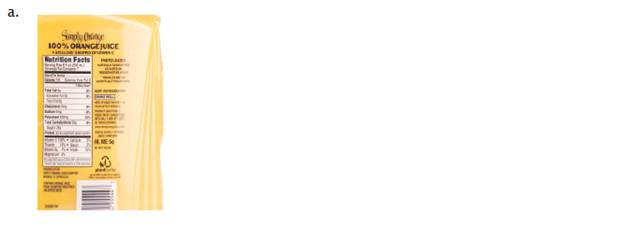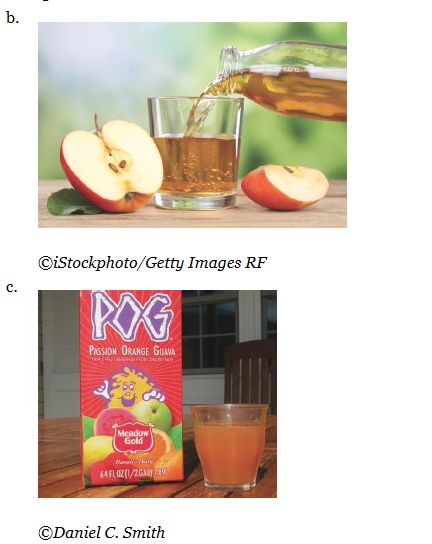
Connect One Semester Access Card for General, Organic, & Biological Chemistry
4th Edition
ISBN: 9781260194654
Author: Janice Gorzynski Smith Dr.
Publisher: McGraw-Hill Education
expand_more
expand_more
format_list_bulleted
Concept explainers
Textbook Question
Chapter 8.1, Problem 8.2P
Use the appearance of each product to classify it as a solution, colloid, or suspension: (a)orange juice (with the label shown); (b) apple juice; (c) passion orange guava (POG) drink.


Expert Solution & Answer
Trending nowThis is a popular solution!

Students have asked these similar questions
Can you please help me with drawing the Lewis structure of each molecular formula?I truly appreciate you!
Can you please help me with drawing the Lewis structure of each molecular formula?I truly appreciate you!
Can you please help me with drawing the Lewis structure of each molecular formula?I truly appreciate you!
Chapter 8 Solutions
Connect One Semester Access Card for General, Organic, & Biological Chemistry
Ch. 8.1 - Classify each substance as a heterogeneous...Ch. 8.1 - Use the appearance of each product to classify it...Ch. 8.2 - Consider the following diagrams for an aqueous...Ch. 8.2 - Classify each solution as an electrolyte or...Ch. 8.2 - Using the given number of moles, determine how...Ch. 8.2 - Prob. 8.2PPCh. 8.2 - A solution contains the following ions:...Ch. 8.2 - If a solution contains 125 mEq of Na+ per liter,...Ch. 8.3 - Which compounds are water soluble? a. NaNO3 b. CH4...Ch. 8.3 - Prob. 8.7P
Ch. 8.3 - Use the solubility rules to predict whether the...Ch. 8.3 - Use the solubility rules for ionic compounds to...Ch. 8.4 - Why does a soft drink become "flat" faster when it...Ch. 8.4 - Predict the effect each change has on the...Ch. 8.5 - A commercial mouthwash contains 4.3 g of ethanol...Ch. 8.5 - What is the weight/volume percent concentration of...Ch. 8.5 - Prob. 8.6PPCh. 8.5 - Prob. 8.7PPCh. 8.5 - A drink sold in a health food store contains 0.50%...Ch. 8.5 - Prob. 8.12PCh. 8.5 - What is the concentration in parts per million of...Ch. 8.6 - Prob. 8.10PPCh. 8.6 - Prob. 8.13PCh. 8.6 - Prob. 8.11PPCh. 8.6 - Prob. 8.12PPCh. 8.6 - How many grams of NaCl are contained in each of...Ch. 8.6 - How many milliliters of a 0.25 M sucrose solution...Ch. 8.7 - What is the concentration of a solution formed by...Ch. 8.7 - If the solution of A+B- in X is diluted, which...Ch. 8.7 - Prob. 8.15PPCh. 8.7 - Prob. 8.16PCh. 8.8 - What is the boiling point of a solution prepared...Ch. 8.8 - Representations A, B, and C each show an aqueous...Ch. 8.8 - Prob. 8.18PPCh. 8.8 - What is the melting point of a solution that is...Ch. 8.9 - Which solution in each pair exerts the greater...Ch. 8.9 - Prob. 8.19PCh. 8.9 - Consider the two aqueous solutions separated by a...Ch. 8.9 - What happens to a red blood cell when it is placed...Ch. 8 - Prob. 21PCh. 8 - Prob. 22PCh. 8 - Prob. 23PCh. 8 - Which representation of molecular art better shows...Ch. 8 - Classify each of the following as a solution,...Ch. 8 - Classify each of the following as a solution,...Ch. 8 - Prob. 27PCh. 8 - Label each diagram as a strong electrolyte, weak...Ch. 8 - Prob. 29PCh. 8 - Prob. 30PCh. 8 - Prob. 31PCh. 8 - Prob. 32PCh. 8 - Consider a mixture of two substances shown in blue...Ch. 8 - Which diagram (C or D) best represents what occurs...Ch. 8 - If the solubilityofKClin 100 mL of H2O is 34 g at...Ch. 8 - If the solubilityofsucrosein 100 mL of H2O is 204...Ch. 8 - Prob. 37PCh. 8 - Prob. 38PCh. 8 - Using the ball-and-stick model for methanol...Ch. 8 - Prob. 40PCh. 8 - Prob. 41PCh. 8 - Prob. 42PCh. 8 - Prob. 43PCh. 8 - Prob. 44PCh. 8 - Prob. 45PCh. 8 - Prob. 46PCh. 8 - Prob. 47PCh. 8 - How is the solubility of helium gas in water...Ch. 8 - Use the solubility rules listed in Section 8.3B to...Ch. 8 - Use the solubility rules listed in Section 8.3B to...Ch. 8 - Prob. 51PCh. 8 - Prob. 52PCh. 8 - Prob. 53PCh. 8 - Prob. 54PCh. 8 - Prob. 55PCh. 8 - Prob. 56PCh. 8 - Prob. 57PCh. 8 - Prob. 58PCh. 8 - How would you use a 250-mL volumetric flask to...Ch. 8 - How would you use a 250-mLvolumetric flask to...Ch. 8 - Prob. 61PCh. 8 - Prob. 62PCh. 8 - Prob. 63PCh. 8 - Prob. 64PCh. 8 - Prob. 65PCh. 8 - What is the molarity of a 20.0% (v/v) aqueous...Ch. 8 - Prob. 67PCh. 8 - Prob. 68PCh. 8 - Prob. 69PCh. 8 - Prob. 70PCh. 8 - Prob. 71PCh. 8 - Prob. 72PCh. 8 - Prob. 73PCh. 8 - Prob. 74PCh. 8 - Prob. 75PCh. 8 - Prob. 76PCh. 8 - Prob. 77PCh. 8 - Representations A (containing 1.0 mol ofNaCl) and...Ch. 8 - What is the boiling point of a solution that...Ch. 8 - Prob. 80PCh. 8 - If 150 g of ethylene glycol (C2H6O2) is added to...Ch. 8 - Prob. 82PCh. 8 - Prob. 83PCh. 8 - Prob. 84PCh. 8 - Which solution in each pair has the higher melting...Ch. 8 - Prob. 86PCh. 8 - A flask contains two compartments (A and B) with...Ch. 8 - A flask contains two compartments (A and B) with...Ch. 8 - The molecular art illustrates a red blood cell in...Ch. 8 - Prob. 90PCh. 8 - Prob. 91PCh. 8 - Explain why more sugar dissolves in a cup of hot...Ch. 8 - If the concentration of glucose in the blood is...Ch. 8 - Prob. 94PCh. 8 - Mannitol, a carbohydrate, is supplied as a 25%...Ch. 8 - A patient receives 750 ml, of a 10.% (w/v) aqueous...Ch. 8 - Explain why a cucumber placed in a concentrated...Ch. 8 - Explain why a cucumber placed in a concentrated...Ch. 8 - Prob. 99PCh. 8 - Prob. 100PCh. 8 - Prob. 101PCh. 8 - Prob. 102PCh. 8 - The therapeutic concentration—the concentration...Ch. 8 - Prob. 104CP
Knowledge Booster
Learn more about
Need a deep-dive on the concept behind this application? Look no further. Learn more about this topic, chemistry and related others by exploring similar questions and additional content below.Similar questions
- Can you please help me with drawing the Lewis structure of each molecular formula?I truly appreciate you!arrow_forwardPlease draw and explainarrow_forwardDescribe each highlighted bond in terms of the overlap of atomic orbitals. (a) Н Н H H [References] HIC H H C H H-C-CC-N: H σ character n character (b) HIC H H H H-C-C-C HIC H Н H O-H σ character n character Submit Answer Try Another Version 3 item attempts remainingarrow_forward
- 11 Naming and drawing alcohols Write the systematic (IUPAC) name for each of the following organic molecules: structure OH HO OH Explanation Check name ☐arrow_forwardwhat is the drawn mechanism for diethyl carbonate and 4 - bromo - N, N -dimethylaniline to create crystal violet?arrow_forwardWhich of the following compounds are constitutional isomers of each other? I and II O II and III O III and IV OI and IV O II and IV CI H CI H CI H H CI H-C-C-CI C-C-C-CI H-C-C-CI H-C-C-CI H CI Ĥ ĆI A A Ĥ ĆI || IVarrow_forward
- Please correct answer and don't used hand raitingarrow_forwardQ1: Curved Arrows, Bronsted Acids & Bases, Lewis Acids & Bases Considering the following reactions: a) Predict the products to complete the reactions. b) Use curved electron-pushing arrows to show the mechanism for the reaction in the forward direction. Redraw some of the compounds to explicitly illustrate all bonds that are broken and all bonds that are formed. c) Label Bronsted acids and bases in the left side of the reactions. Label conjugate acids and bases in the right side of the reactions. d) Label Lewis acids and bases, nucleophiles and electrophiles in the left side of the reactions. A. + OH CH30: OH B. + HBr C. H₂SO4 D. CF 3. CH 3 + HCI N H fluoxetine antidepressant 1↓ JDownloadarrow_forwardDon't used Ai solutionarrow_forward
- Part 3: AHm,system Mass of 1.00 M HCI Vol. of 1.00 M HCI Mass of NaOH(s) Total Mass in Calorimeter Mole product if HCI limiting reactant Trial 1 62.4009 1.511g Mole product if NaOH limiting reactant Limiting reactant Initial Temperature Final Temperature 23.8°C 37.6°C Change in Temperature AHm,system (calculated) Average AHm,system (calculated) (calculated) (calculated) Trial 2 64.006g 1.9599 (calculated) (calculated) (calculated) (calculated) (calculated) (calculated) 24.7°C 41.9°C (calculated) (calculated) (2 pts. each)arrow_forwardDon't used Ai solutionarrow_forwardWhat is the numerical value of the slope using the equation y=-1.823x -0.0162 please show calculationsarrow_forward
arrow_back_ios
SEE MORE QUESTIONS
arrow_forward_ios
Recommended textbooks for you
- Chemistry: Matter and ChangeChemistryISBN:9780078746376Author:Dinah Zike, Laurel Dingrando, Nicholas Hainen, Cheryl WistromPublisher:Glencoe/McGraw-Hill School Pub Co
 ChemistryChemistryISBN:9781305957404Author:Steven S. Zumdahl, Susan A. Zumdahl, Donald J. DeCostePublisher:Cengage Learning
ChemistryChemistryISBN:9781305957404Author:Steven S. Zumdahl, Susan A. Zumdahl, Donald J. DeCostePublisher:Cengage Learning Chemistry: An Atoms First ApproachChemistryISBN:9781305079243Author:Steven S. Zumdahl, Susan A. ZumdahlPublisher:Cengage Learning
Chemistry: An Atoms First ApproachChemistryISBN:9781305079243Author:Steven S. Zumdahl, Susan A. ZumdahlPublisher:Cengage Learning 
 General Chemistry - Standalone book (MindTap Cour...ChemistryISBN:9781305580343Author:Steven D. Gammon, Ebbing, Darrell Ebbing, Steven D., Darrell; Gammon, Darrell Ebbing; Steven D. Gammon, Darrell D.; Gammon, Ebbing; Steven D. Gammon; DarrellPublisher:Cengage Learning
General Chemistry - Standalone book (MindTap Cour...ChemistryISBN:9781305580343Author:Steven D. Gammon, Ebbing, Darrell Ebbing, Steven D., Darrell; Gammon, Darrell Ebbing; Steven D. Gammon, Darrell D.; Gammon, Ebbing; Steven D. Gammon; DarrellPublisher:Cengage Learning Chemistry by OpenStax (2015-05-04)ChemistryISBN:9781938168390Author:Klaus Theopold, Richard H Langley, Paul Flowers, William R. Robinson, Mark BlaserPublisher:OpenStax
Chemistry by OpenStax (2015-05-04)ChemistryISBN:9781938168390Author:Klaus Theopold, Richard H Langley, Paul Flowers, William R. Robinson, Mark BlaserPublisher:OpenStax

Chemistry: Matter and Change
Chemistry
ISBN:9780078746376
Author:Dinah Zike, Laurel Dingrando, Nicholas Hainen, Cheryl Wistrom
Publisher:Glencoe/McGraw-Hill School Pub Co

Chemistry
Chemistry
ISBN:9781305957404
Author:Steven S. Zumdahl, Susan A. Zumdahl, Donald J. DeCoste
Publisher:Cengage Learning

Chemistry: An Atoms First Approach
Chemistry
ISBN:9781305079243
Author:Steven S. Zumdahl, Susan A. Zumdahl
Publisher:Cengage Learning


General Chemistry - Standalone book (MindTap Cour...
Chemistry
ISBN:9781305580343
Author:Steven D. Gammon, Ebbing, Darrell Ebbing, Steven D., Darrell; Gammon, Darrell Ebbing; Steven D. Gammon, Darrell D.; Gammon, Ebbing; Steven D. Gammon; Darrell
Publisher:Cengage Learning

Chemistry by OpenStax (2015-05-04)
Chemistry
ISBN:9781938168390
Author:Klaus Theopold, Richard H Langley, Paul Flowers, William R. Robinson, Mark Blaser
Publisher:OpenStax
Solutions: Crash Course Chemistry #27; Author: Crash Course;https://www.youtube.com/watch?v=9h2f1Bjr0p4;License: Standard YouTube License, CC-BY